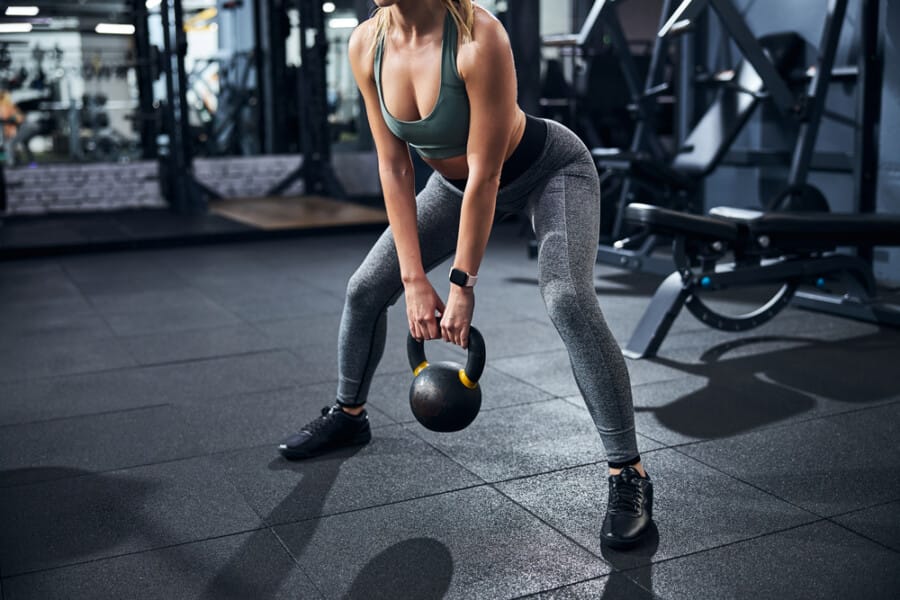Sumo squats represent a highly efficient exercise for fortifying and sculpting your glutes and inner thighs, while also enhancing hip flexibility. By making slight adjustments to the conventional squat stance, the sumo squat activates your muscles in a distinctive manner, providing significant advantages when integrated into your workout routine.
The moniker ‘sumo squat’ derives from its resemblance to the stance of a classic sumo wrestler.
“This version entails spreading your feet wider with toes pointing outward, setting it apart from the regular squat,” elucidates Joey Thurman, CPT, a certified personal trainer, author, and founder of Fun Fitness Bros. “The sumo squat is especially advantageous for individuals looking to enhance their lower-body strength.”
Whether you are a beginner or a seasoned squatter, there exist numerous sumo squat adaptations to challenge your physique.
“It’s commonly performed with a weight placed near the shins or feet. The additional resistance can assist in achieving greater depth owing to the open hip position and the downward pull of the weight,” adds Thurman.
Maintaining correct posture is essential to maximize benefits and prevent injuries. Let’s kick off by comprehending how to execute the sumo squat correctly, followed by insights on the muscles targeted, benefits, common mistakes, and alternative variations to try out.
Mastering the Art of Sumo Squatting
Prioritize mastering the accurate sumo squat form using only your body weight before incorporating extra resistance such as a kettlebell, barbell, or dumbbell. In case you require a recap on performing a squat with proper technique, we’ve got you covered.
- Place your feet slightly wider than hip-width apart, with arms hanging down by your sides.
- Rotate your toes outward at a 45-degree angle.
- Maintain an erect chest posture, bend your knees, push your hips back, and transfer your weight onto your heels while descending into the squat, as if preparing to perch on a chair.
- Stretch out your arms in front as you lower into the squat.
- Descend as far as comfortable or until your thighs align parallel to the ground.
- Propel through your heels to rise back to a standing stance.
- Repeat for 2 to 3 sets consisting of 8 to 12 repetitions.
Tip: Utilizing weight plates beneath your heels (as demonstrated by Thurman) can aid in achieving a deeper squat depth.
Muscles Focused by Sumo Squats
“Sumo squats serve as an efficacious movement for boosting leg power and enhancing leg muscle mass,” observes Grayson Wickham, DPT, CSCS, a physical therapist and founder of Movement Vault.
Sumo squats activate the same muscle groups as conventional squats, with specific emphasis on particular muscles due to the foot placement.
- Glutes: The gluteal muscles (gluteus maximus, medius, and minimus) are primary targets during sumo squats.
- Adductors: A study from 2021 published in the International Journal of Environmental Research and Public Health suggests that sumo squats target the adductor muscles (inner thighs) more effectively than regular squats due to the wide stance and toe orientation.
- Quadriceps: The quadriceps (quads), the predominant muscles at the anterior of your thigh, experience reinforcement during sumo squats, focusing on the vastus lateralis part of the muscle per the International Journal of Environmental Research and Public Health study.
- Hamstrings: These posterior thigh muscles receive substantial activation during sumo squats.
- Calves: Your calf muscles aid in stabilizing your foot and ankle throughout the squat.
- Core: Beyond the lower body, your core muscles engage in stabilizing your body during sumo squats due to the upright trunk posture.
Benefits of Adding Sumo Squats to Your Fitness Routine
Uncover six compelling rationales why including sumo squats is crucial in your workout regimen.
1. Enhancing Inner Thighs
“The wider stance and outwardly turned feet in sumo squats activate the adductor muscles of the inner thighs, complementing the activation of glutes and quads,” expounds Thurman. This is corroborated by a 2017 study in the Journal of Strength and Conditioning Research.
In addition to targeting the aforementioned muscles, sumo squats also engage the hamstrings, calves, and core.
2. Boosting Hip Mobility
“Sumo squats contribute to enhanced hip flexibility and range of motion due to the specific hip angle required,” accents Thurman.
3. Mitigating Back Strain
As per Thurman, when executing sumo squats with added resistance, the weight is clasped lower and nearer to your body’s center of gravity, diminishing lower back strain compared to other squat variations or when holding the weight higher.
Furthermore, sumo squats fortify core muscles, offering support to your back and aiding in injury prevention.
4. Easing Ankle Joint Pressure
Individuals with restricted ankle mobility, whether due to injury or tight calves, may discover sumo squats gentler on the ankle joint than traditional squats.
“The primary advantage of sumo squats over standard squats lies in the reduced demand on ankle mobility, particularly the decreased necessity for ankle dorsiflexion,” highlights Wickham.
5. Functional Training
By activating the same muscles used in everyday movements such as sitting, standing, climbing stairs, and stepping over obstacles, sumo squats enhance your functional capabilities.
The benefits of sumo squats can extend to athletic endeavors, potentially enhancing performance in activities like running, jumping, and sports such as basketball or tennis.
6. Flexibility
“Sumo squats can be executed with a variety of equipment—dumbbells, kettlebells, barbells— or using only your body weight, catering to a diverse range of fitness levels,” underlines Thurman.
Diverse Sumo Squat Varieties for Added Flair
Once you have perfected the fundamental sumo squat, experiment with one or more of these alternative sumo squat versions.
1. Weighted Sumo Squat
Incorporate a kettlebell or dumbbell to intensify resistance in this exercise. Adding weight not only amplifies muscle engagement but also encourages deeper squatting, consequently enhancing hip mobility and broadening the scope of muscle activation, according to Thurman.
- Commence by standing with your feet slightly wider than hip-width apart.
- Angle your toes outward at a 45-degree stance.
- Grasp a kettlebell or dumbbell with both hands in front of you, arms extended downward.
- Keep your chest elevated, bend your knees, push your hips back, and lower into a squat as if lowering onto a chair.
- Descend until your thighs align parallel to the floor.
- Propel through your heels to return to a standing post.
- Repeat for 2 to 3 sets comprising of 8 to 12 reps.
2. Sumo Squat with Overhead Press
This exercise engages your shoulders, back, arms, legs, and core. Initiate with a lighter resistance and increment gradually.
- Plant your feet slightly wider than hip-width apart.
- Direct your toes outward at a 45-degree angle.
- Clutch a dumbbell in each hand near your shoulders with elbows facing forward.
- Keep your chest upright, bend your knees, push your hips back, and lower into a squat as if about to sit down.
- Descend until your thighs align parallel to the floor.
- Propel through your heels to stand up and press both arms overhead.
- Return to the initial stance.
- Repeat for 2 to 3 sets consisting of 8 to 12 repetitions.
3. Sumo Squat with Hop
This variantincorporates a plyometric aspect that targets your lower limbs, inner thighs, and elevates your heart rate.
- Begin by standing with your feet slightly wider than the width of your hips.
- Rotate your toes outwards at a 45-degree angle.
- Grasp a kettlebell or dumbbell with both hands in front of you, ensuring your arms are extended downward.
- Maintain an upright posture, bend your knees, push your hips back, and descend into a squat as if you were lowering onto a chair.
- Descend until your thighs reach a position parallel to the ground.
- Propel yourself upward by pushing through your heels, perform a jump, and land with your knees slightly flexed.
- Repeat for 2 to 3 sets consisting of 8 to 12 repetitions.
Steer clear of these common errors during sumo squats
Observe yourself in the mirror to avert these common missteps in the execution of sumo squats.
1. Incorrect width of stance
Unlike traditional squats, in sumo squats, your feet should be positioned wider than the width of your hips.
A narrow stance may diminish effectiveness and muscle activation, as indicated by Thurman.
2. Arching your back
Maintain a straight back throughout the exercise to prevent strain on your spine.
Maintaining a neutral spine is crucial to avoid complications, as recommended by Wickham.
3. Inadequately turned out toes
To ensure proper alignment of your knees and activation of muscles, make sure to rotate your toes out to a 45-degree angle during sumo squats.
It is crucial for optimal muscle engagement, as emphasized by Thurman.
Your knees should align with your feet, as instructed by Wickham.
4. Insufficient squat depth
Strive to descend your hips below your knees or at least until your thighs are parallel to the floor.
Adequate depth is essential for targeting the correct muscles, according to Thurman.
Focus on gradually enhancing your depth as you develop strength and mobility.
FAQs
1. Are sumo squats more effective than standard squats?
According to Wickham, the decision between sumo squats and regular squats is dependent on your fitness objectives.
For concentrating on the inner thighs, opt for sumo squats. Incorporating both varieties in your workout regimen can be beneficial.
2. Should sumo squats be performed daily?
Thurman advises against conducting sumo squats daily to avoid muscle imbalances and overexertion. Rest days and diversity in exercises are crucial for overall well-being.
Engaging in repetitive high-intensity training without sufficient recovery time may result in injuries, as pointed out by Thurman.
3. How long should a sumo squat be held for?
While the emphasis is on movement, a brief pause at the bottom of the squat can enhance muscle activation and strength gains, according to Thurman. Ensure proper form during the pause.










